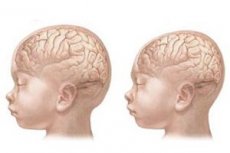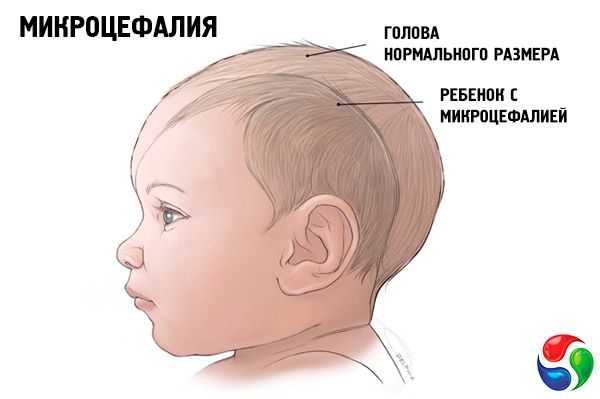Medical expert of the article
New publications
Microcephaly
Last reviewed: 04.07.2025

All iLive content is medically reviewed or fact checked to ensure as much factual accuracy as possible.
We have strict sourcing guidelines and only link to reputable media sites, academic research institutions and, whenever possible, medically peer reviewed studies. Note that the numbers in parentheses ([1], [2], etc.) are clickable links to these studies.
If you feel that any of our content is inaccurate, out-of-date, or otherwise questionable, please select it and press Ctrl + Enter.

Microcephaly is an extremely severe incurable pathology characterized by underdevelopment of the skull, insufficient functioning of the brain, feeblemindedness and other psychoneurological anomalies. In many cases, microcephaly causes the development of oligophrenia. Often, the pathology is combined with other malformations of the central nervous system, spastic paralysis, and convulsions.
Causes microcephaly
The disease is related to congenital malformations of the nervous system.
The causes of microcephaly development include radioactive impact on the body, intrauterine infectious pathologies, genetic predisposition, toxic factors, chromosomal abnormalities. The cause of the pathology may be the use of alcohol or drugs by the expectant mother during the period of bearing a child.
 [ 8 ]
[ 8 ]
Symptoms microcephaly
- complete or partial absence of the corpus callosum (nerve fibers connecting the right and left hemispheres).
- abnormally wide convolutions of the brain.
- very narrow or thin convolutions of the entire brain or its individual segments.
- atypical tissue localization.
- Lissencephaly - smoothing of the convolutions of the cerebral cortex.
External signs of microcephaly include a disproportionate relationship between the size of the body and the skull and premature closure of the fontanelle.

Microcephaly in newborns
Microcephaly in newborns manifests itself in the form of various neurological disorders and seizures. In addition to mental retardation, there are motor function disorders that manifest themselves later. In newborns with microcephaly, the cranial volume is reduced at birth and subsequently does not increase, although the development of the facial part may correspond to the norms. As a result, the size of the head is not proportional to the size of the body, the forehead has a flat shape, the skin of the head is wrinkled. Over time, the discrepancy between the size of the head and body becomes more pronounced, while the height and weight indicators are also significantly less than normal.
Forms
- Congenital microcephaly is an abnormally small development of the skull and insufficient development of the brain against the background of normal body size.
- Primary microcephaly develops as a result of traumatic factors in the first or second trimester of pregnancy.
- Secondary occurs as a result of negative impacts on the fetus in the third trimester of pregnancy, during childbirth or in the first months after birth.
Secondary microcephaly occurs when the fetus is exposed to harmful factors in the third trimester of pregnancy, as well as during labor and the first months of life. Such factors may include fetal infections, lack of oxygen, trauma, alcohol or drug use by the expectant mother. In addition to insufficient brain weight, patients have foci of destruction (cysts, porencephaly), hemorrhages, inflammatory processes, areas of tissue dystrophy or necrosis. The ventricles of the brain are usually dilated. At birth, the diameter of the head may not be significantly reduced, but later its development slows down, the skull acquires asymmetrical shapes, signs of cerebral palsy (CP) are noted, and signs of mental retardation are severe. The prognosis for the outcome of the disease is unsatisfactory.
Diagnostics microcephaly
Microcephaly is one of the most difficult pathologies to diagnose in the prenatal period.
A decrease in the head circumference of adults to forty-eight centimeters or less with a brain mass below nine hundred to one thousand grams allows us to speak of a diagnosis of microcephaly. The brain mass of children suffering from microcephaly ranges from two hundred and fifty to nine hundred grams. The head circumference is thirty to forty centimeters. However, cases of lower indicators of weight and brain volume have been recorded.
Microcephaly is difficult to diagnose on ultrasound due to the lack of general criteria for this pathology. The diagnosis can be assumed if the fetal head circumference is reduced by 2 SD and 3 SD, the change in the ratio of the head diameter to the length of the femur is less than two and a half percentiles. It should be noted that sometimes the assessment of the results of measuring the fetal head circumference is problematic due to the lack of accurate information about the gestational age or due to a violation in the formation of the skeletal system.
What do need to examine?
Who to contact?
Treatment microcephaly
There is no specific treatment. In all cases, therapy is symptomatic and aimed at maintaining the life of patients. Microcephaly is not treatable and has an unfavorable prognosis for development and outcome. As a rule, patients with this diagnosis are in special institutions for patients with brain malformations.
Forecast
The outcome of the disease in all cases is unsatisfactory, since such pathology is incurable. Maintenance therapy gives insignificant results, patients are under observation in special institutions for people with mental disabilities.
Life expectancy with microcephaly
Life expectancy in microcephaly is usually short due to the insufficient development and functioning of the brain. Most often, people suffering from this pathology die as a result of infectious lesions.

